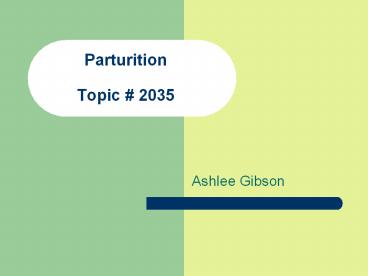Parturition Topic 2035 - PowerPoint PPT Presentation
1 / 14
Title:
Parturition Topic 2035
Description:
Parturition Topic # 2035 Ashlee Gibson What is Parturition? Act of process of giving birth Parturition Names in Species Cattle: Calving Sheep: Lambing Swine ... – PowerPoint PPT presentation
Number of Views:446
Avg rating:3.0/5.0
Title: Parturition Topic 2035
1
ParturitionTopic 2035
- Ashlee Gibson
2
What is Parturition?
- Act of process of giving birth
3
Parturition Names in Species
- Cattle Calving
- Sheep Lambing
- Swine Farrowing
- Horses Foaling
4
Signs of Approaching Parturition
- Distended abdomen
- Mammary development milk secretion
- Swollen vulva and relaxed pelvic ligaments
- Mucous discharge
- Relentlessness and separation from group
- Labor and Contractions
5
Signs of Parturition in Cattle
- One week - mammary glands fill with milk,
tailhead ligaments relax, and you will see a
waxing of teats. - 12-24 hours - frequent defecation and urination,
anorexia, looking for young, makes a nest or
seeks out an isolated area.
6
Signs of Parturition in Sheep
- Ten days before lambing the ewes teats become
firm and full of milk, her vulva slackens and
becomes slightly swollen. - Closer to lambing, the ewe's cervical seal passes
from the vulva as a thick, creamy, white mucus. - In the final stages prior to lambing, the ewe
becomes anxious and uneasy and continually
switches from a reclining to a standing position.
7
Signs of Parturition in Horses
- Two to six weeks before foaling the mares udder
will swell. - Seven to ten days prior to foaling the muscles
over the buttocks appear to shrink and the
abdomen drops. - At four to six days before foaling the teats fill
with milk. - Twelve to 24 hours before foaling wax appears on
the end of the nipples.
8
Stages of Parturition
- Stage 1- Preparatory Stage
- Stage 2- Birthing Process
- Stage 3- Placenta Expulsion
9
Stage 1- preparatory stage
- Characterized by dilation of the cervix.
- Rhythmic contractions of the uterus.
- At the end of this stage, the cervix expands,
allowing the uterus and vagina to become a
continuous canal.
10
Stage 2- Birthing Process
- Increase in contractions with abdominal pressing.
- The placenta, along with the head and forelegs,
are forced into the vagina (birth canal). - Presentation is forelegs first with the nose
resting on the forelegs. - Anterior head first
- In swine, piglets may be born anteriorly or
posteriorly
11
Stage 3- Placenta Expulsion
- Associated with uterine contractions
- Normally expelled within 12 hours
- Placenta of each species should be expelled
within the following time periods - Mare- one hour
- Cow and ewe- 8to 24 hours
- Sow normally attached to fetus at birth
12
Types of Placentas
- Cotyledonary
- Cow Ewe
- Diffuse
- Mare Sow
13
Dystocia Difficulty during Parturition
- Fetal dystocia problems
- Over-sized fetus
- Multiple birth complications
- Breech presentation - With sheep, cattle, and
horses, the fetus is presented posteriorly. - Deviations in normal presentation - For example,
one leg may be pushed back or the head may be
turned.
14
Dystocia
- Maternal dystocia problems
- Narrowing of the birth canal due to fractures of
the pelvis. - Uterine torsion reducing the size of the birth
canal. - The cervix may fail to dilate.
- Absence of uterine contractions































